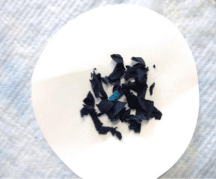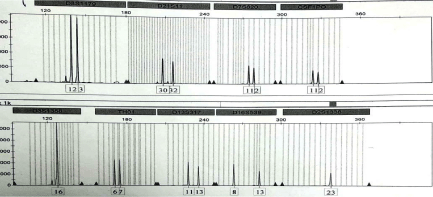
Case Report
Austin J Clin Case Rep. 2019; 6(3): 1147.
Presence of Vaginal Secretion on Accused’s Underwear in Absence of Semen and Blood on Victims Swabs/Clothings as a Proof of Sexual Assault: A Report
Chakravarty M1,2*, Singh N1, Sharma D1, Sharma N1, Pandya P2 and Raina A3
¹Forensic Science Laboratory, Home Department, Government of NCT Delhi, Rohini, India
²Amity Institute of Forensic Sciences, Amity University, Noida, Uttar Pradesh, India
³All India Institute of Medical Sciences, Delhi, India
*Corresponding author: Chakravarty M, Forensic Science Laboratory, Home Department, Government of NCT Delhi, Sector14, Rohini, Delhi, India
Received: April 29, 2019; Accepted: June 03, 2019; Published: June 10, 2019
Abstract
The sexual assault cases are on a rise now a days. Here we present a case of an eleven years old child who was a victim of sexual abuse. On preliminary examination, blood and semen could not be detected on the swabs/clothing’s of victim. However, some white stains were visible on the underwear of the accused, which tested negative for semen. DNA profiling was conducted for the samples. Multiplex STR typing was used to study the 15 STR Loci in addition to a gender identification marker, amelogenin by capillary electrophoresis on 3500 xl Genetic Analyzer. It was observed that the profiles generated from the underwear of accused matched with the victim’s DNA profile. Thus with DNA fingerprinting technique the case was concluded, linking the victim and the assailant even in the absence of semen and blood on the samples of victim.
Keywords: Semen; DNA; Loci; Electrophoresis; STR
Introduction
Human genome comprise of 3x109 base pairs. Out of these only 30,000 base pairs are coding & the rest non coding DNA sequences. STR loci are the polymorphic regions found in the genome that are used as genetic markers for human identification-forensic case work, data basing and paternity testing. DNA fingerprinting was first described by Jeffrey et al. [1]. They found that certain regions of DNA contain repeated DNA sequences which they referred to as variable number of tandem repeats. The microsatellites are short sequences of nucleotides; 3-7 base pairs repeated over and over again a variable number of times in tandem. Polymorphic STR loci are the most informative PCR based genetic markers for attempting to individualise biological material due to variation between individual found in these regions. The combination of DNA based tests and regularly used cytological tests have increased male evidence detection rates in forensic case work [2].
Case Presentation
Fifty three percent of children in India face some from of child sexual abuse [3]. With childhood sexual abuse, victims are after too young to know how to express or to know what is happening. When not treated properly it leads to depression & anxiety. Here we report a case, where a 10yrs. old child was undertaking music classes from a tutor aged 37yrs. since last 2 years. One evening the mother of the victim saw the daughter lying in bed without clothes and this tutor leaving the room silently. The child narrated to her mother that the tutor strips her clothes daily and assaults her. FIR was lodged on the very next day of the incident under Protection of children against sexual offence Act, 2012 [4] & 376 IPC POCSO. POCSO Act was passed by both the houses of Parliament on May 22, 2012. The act defines a child as any person below the age of 18. It deems a sexual assault to be ‘aggravated’ under certain circumstances, such as when the abused child is mentally unstable or when the abuse is committed by a person in a position of trust or a authority like a family member, family friend, teacher or doctor. Punishments include imprisonment from not less than at least 3 years extending up to 7 years to life imprisonment and a fine. According to IPC section 376, “whoever, except in the case provided for in sub section commits rape, shall be punished with rigorous imprisonment of either description for a term which shall not be less than seven years but which may extend to imprisonment for life, and shall also be liable to fine.”
Loci
(Blood sample) of victim
(Underwear) of the accused
D8S1179
12
13
12
13
D21S11
30
32
30
32
D7S820
11
12
11
12
CSF1PO
11
12
11
12
D3S1358
16
16
16
16
THO1
6
7
6
7
D13S317
11
13
11
13
D16S539
8
13
8
13
D2S1338
23
23
23
23
D19S433
13
13
13
13
vWA
17
17
17
17
TPOX
8
13
8
13
D18S51
14
18
14
18
D5S818
11
12
11
12
FGA
23
24
23
24
AMELOGENIN
X
X
X
X
Table 1: Allelic Data table for the samples.
The tutor was arrested. The medical examination of victim and the suspect was conducted on the same day. There was no delay in medical examination of the victim & accused, which proved to be very helpful in the present case. Doctors collected the clothings of the victim along with the swabs and her blood sample using SAFE (Sexual Assault Forensic Examination kit). Doctors opined an old hymen tear and no bleeding. Potency test of the suspect was conducted and the blood sample in gauze along with the underwear of suspect were preserved. The case was deposited/submitted in the biology division of FSL (Forensic Science Laboratory, Delhi) for examination. The exhibits were stored at 40C as per standard protocol to prevent degradation of the samples. Due to huge pendency of cases in the laboratory, the case was taken up for examination after about 41days of the incident.
Materials and Methods
Preliminary tests for the presence of blood and semen were conducted. Identification of blood was done using tetramethylbenzidine (a derivative of benzedine) followed by adding 3% H2O2 as an assay for the presence of blood. The test depends on the presence of an enzyme peroxidase in haemoglobin. Peroxidase acts as catalytic agent to accelerate the liberation of oxygen from hydrogen peroxide (an oxygen rich compound) in the reagent and thus causing oxidation of benzidine to give rise to blue color [5]. The exhibits were subjected to the preliminary tests for the presence of semen. The Acid Phosphate activity test / sodium alpha naphthyl phosphate method [6] (as prostate gland being the abundant source of AP) and microscopic examination of spermatozoa (Sperm Cytology) were carried out. Sperm heads could not be seen on the same.
Both blood and semen were found to be negative on the exhibits belonging to the victim. Although biological tests were found to be negative still the swabs and garments of victim were subjected to differential DNA Extraction. No male DNA profiles could be generated from these exhibits. On the undergarments of the suspect, whitish stains were found which tested negative for semen, using Acid Phosphate method and microscopic detection of sperm heads (Figure 1).

Figure 1: Cuttings taken from the underwear of accused.
Further, the stains were tested for the identification of salivary amylases using starch Iodine test. Amylases are enzymes that cleave polysaccharides such as Starch. The identification of saliva is largely based on the presence of amylase in a sample and Iodine is used to test for the presence of the amylase. Tests were found to be negative.
DNA examination
Blood sample of victim was taken on FTA card, card was punched into the tube, washed with FTA buffer twice and with 1X TE thrice. Automate Express DNA extraction system using the Prepfiler Express Forensic DNA extraction Kit was used to extract DNA from the suspect’s underwear.
DNA quantification
Multiplexing was carried out using this kit and 15 STR loci along with sex determining amelogenin were amplified in a single reaction [7].
Electrophoresis was carried out on ABI 3500xl Automated Genetic Analyser using 36cm capillary on POP4 polymer (Applied Biosystems, Foster City, USA.) 0.5μl of amplified DNA was mixed with 9.5μl HiDi Formamide and 0.3μl Gene Scan 500Liz size standard.
Mixture was denatured at 95°C for 3 minutes followed by lowering the temperature to 4°C for 3 minutes. The denatured samples were loaded on to the sample tray and transferred to auto sampler. Allelic ladder was run as a part of batch of samples.
Data analysis
Gene mapper Idx software v 1.2 was used for the analysis of samples .The samples were sized according to internal size standard. The software uses the internal size standard to assign a fragment size and a sizing quality value to each peak (Figure 2 & 3).

Figure 2: Electropherogram showing panel 1 & 2 of the Blood sample of victim.

Figure 1: Electropherogram showing panel 1 & 2 of the underwear of the accused.
Results and Discussions
Sexual assault cases involve the analysis of vaginal samples and garments. The objective behind this analysis is the detection of sperms and the generation of assailant’s DNA profile. Microscopic analysis, presumptive testing for body fluid identity, DNA isolation and profiling are performed on those samples. DNA isolation is generally done by differential extraction in which female DNA (mostly from vaginal epithelia) is separated from the male fraction. When less or no sperm cells are present or the ratio of female to male is not favourable partial or incomplete male DNA profiles are obtained [8].
With the advancement of DNA technology and understanding of DNA transfer, the collection of the suspect’s underwear along with penile swabs if less than 48 hours had passed between the assault and the apprehension of the suspect is done. These samples are also tested now days for the presence of the victim’s DNA on the suspect, thus making a link between the two individuals [9].
Conclusions
In rape forensic investigations, semen identification is required to corroborate the alleged crime. Such type of cases are frequently examined in forensic laboratories. The presence of female DNA whether through saliva or vaginal fluid of the samples of attacker is expected in cases involving transfer. In the present case where sperm or blood cells are absent, female DNA identified represents the viable source of DNA analysis. It proved that accused person was involved in rape case.
References
- Jeffery’s AJ, Wilson V, Thein SL. Hypervariable mini satellite regions in human DNA. Nature. 1985; 314: 67-73.
- Stange V, Pelicao FS, Mendonca JB, Pissinate JF, Barbirato C, et al. Increased Male Evidence Detection Rates by Utilization of DNA Markers in Forensic Rape Cases of Espirito Santo, Brazil. Ann Forensic Res Anal. 2014; 1: 1008.
- The sounds of Silence: Child sexual abuse in India. The morung Express. 2014.
- The protection of children from sexual offences Act. 2012.
- BS Chowdhuri. Examination of biological stains.
- Sensabaugh GF. Isolation characterization of a semen-specific protein from human seminal plasma: a potential new marker for semen identification. J Forensic Sci. 1978; 23: 106-115.
- Applied Biosystems, AmpFISTR Identifiler Plus PCR Amplification Kit, User’s Manual, Applied Biosystems, Foster City.
- Benschop CCG, et al. Post-Coital vaginal sampling with nylon flocked swabs improves DNA typing. Forensic Sci. Int. Genet. 2010; 4: 115-121.
- Detecting the presence of Male DNA in cases of sexual Assault without Ejaculation. TASA ID: 1358.